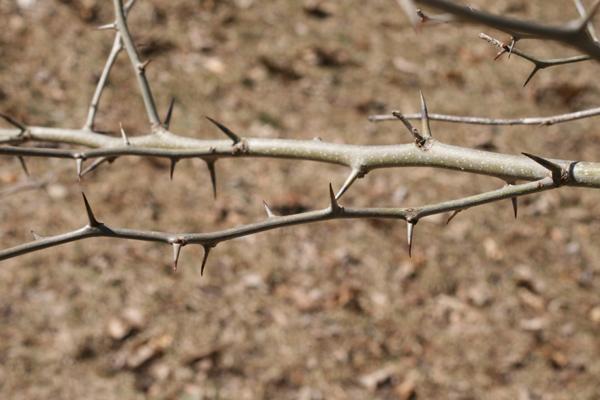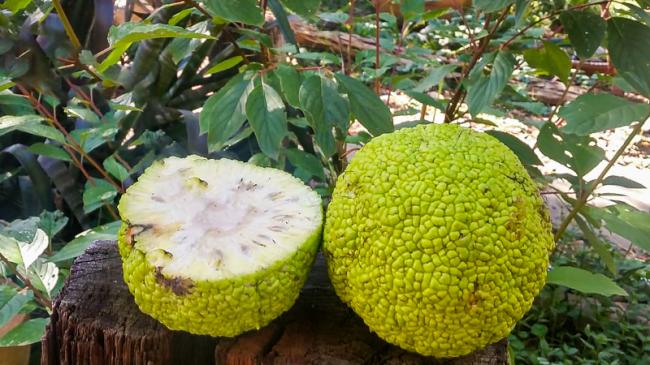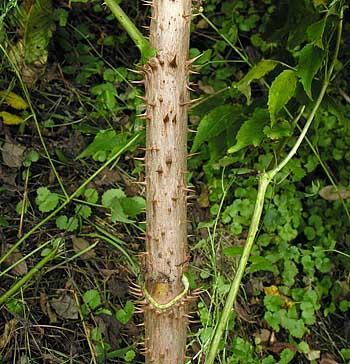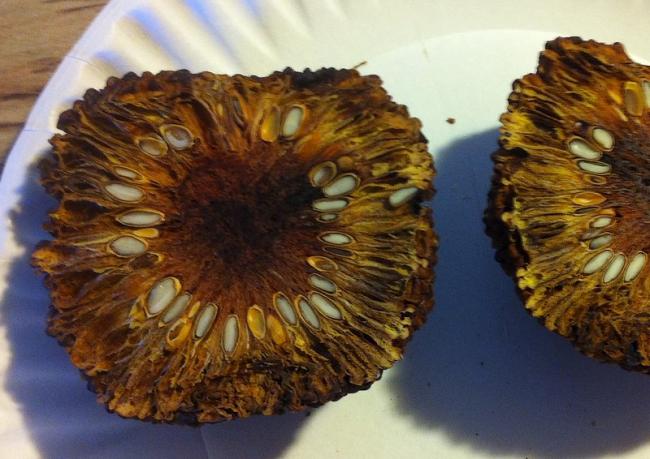Thorn bushes for fencing
https://www.popularmechanics.com/science/environment/g2924/9-plants-deadly/
Good evening,
I’m introducing a natural way to create a security fence.
Using plants, bushes, other botany stuff with thorns can serve as barbed wire.
Above link provides narrative and good pictures. Link is not the most current on web but believe the pictures are best when compared to other links had just checked.
Of course, one must check what growing zone applicable to the different types.
-
Comments (22)
-
RedneckContributor - April 30, 2021
Around here, a wild, very hardy, small tree called Osage Orange can easily be used for fencing. It is very common in our woods & especially around fence lines. If pruned, it stays a large, very dense shrub full of nasty thorns. It is also called horse apple, because of the very large fruit & Bodark from the French words for bow wood. Many consider it the world’s best wood for making archery bows.
The nastiest beast we have in our woods is called Devil’s Walking Stick. It also would make a great fence. It is very common on steep hillsides along ravines. It is all in my woods. What makes it so bad is that it grows in an area where a hiker might slip, moving up or down the slope. It has no lower branches, thus the name walking stick, so it appears to be something you can grab hold of to steady yourself. DON”T.
But if you want a security fence made from a thorny plant there are other considerations besides how thorny it is. As stated, it must grow in your area and grow rapidly. But most importantly, you need a very easy way to propagate the plant.
That is why Osage Orange shines as a security fence. That grapefruit sized fruit is just loaded with seed that are easy to collect & replant.
-
Bob - May 1, 2021
Good afternoon Redneck,
Real good pictures !
I find tranquility looking at these thorn-producers no less so than looking at roses.
-
Conrad B - May 1, 2021
I’ve never seen that fruit before, how do you eat it?
What does it taste like?
-
RedneckContributor - May 1, 2021
It ain’t for eatin’ 🙂
-
Conrad B - May 1, 2021
Oh.. haha 🙂
-
Sun Yeti - May 1, 2021
Apparently, giant ground sloths thought it was delicious. You can still still the footprints of that extinct animal (probably hunted to extinction) in fruits like osage orange, pawpaw, and avocado.
I’ve read that the seeds of the osage orange are edible, the flesh of the fruit is not, so if you want to eat it, you have to remove the seeds, clean the flesh off them, and cook them. Seems like a lot of work, but I’m going to try it this season.
-
Conrad B - May 1, 2021
Let me know if you do end up eating the seeds. Curious what they taste like. Probably not that good, I haven’t seen people rushing to the stores to buy these seeds like they do peanuts or walnuts.
-
-
smalltimehomesteader - May 3, 2021
We have this! Not your exact kind but the people who lived here before us basically did this. One of the plants they used, which serves as a 2 in 1, was big thorny raspberry bushes. So…food, but also very thorny types. I know where to look and how to get the fruit from living here for a while but the thorns will prevent others from getting in. Unless desperation of course.
-
Conrad B - May 3, 2021
Do you just need to use thick leather gloves when pruning and harvesting the raspberries?
-
smalltimehomesteader - May 3, 2021
I should, but I don’t. I know. My husband is always rolling his eyes at me because I sometimes get stabbed but enough practice that it’s not awful. Most often because I’ll just be walking by there & spy a patch of red in between all the thorns & decide to pick it right then and there.
-
-
UbiqueContributor - May 3, 2021
Good afternoon Bob,
Sea buckthorn has nasty thorns but also some excellent medicinal value. One of the highest Vitamin C plus other attibutes. Fruit can be preserved.
http://www.omafra.gov.on.ca/english/crops/facts/seabuckthorn.htm
Also, I am trying to track down the name of a nasty thorny bush that was planted for security purposes by the City of Richmond BC. If I can get the name of it, I will post it here for you.
-
Bob - May 3, 2021
Good afternoon Ubique,
Just glanced at the OMAFRA Ontario site and also surfed around it. It’s a good source of info.
I like the Sea Buckthorn’s additional name “Siberian Pinapple” !
Sea Buckthorn is definitely a cold weather form of botany: can survive at – 40 C.
Foot Note: I like buck wheat (groats ?) more so than rye.
-
UbiqueContributor - May 9, 2021
Good morning Bob,
Reply notifications working now.
Sea Buckthorn has medicinal qualities that are a nice bonus, plus the fruit can be made into a jam or dried.
Ditto on the buckwheat over rye, although if hungry rye could look good too.
-
Bob - May 9, 2021
Good morning Ubique,
Definitely buckwheat as premier product although during a survival situation even will consider cornbread. Life requires sacrifices.
China has a Sea Buck-Thorn R&D Institute.
-
RedneckContributor - May 9, 2021
Sacrifice? Dude, you need to spend some time in the south. 🙂 Dip your cornbread in the collard pot liquor and soon you will be speaking slower & with a Mississippi accent.
-
Bob - May 9, 2021
Good afternoon Redneck,
Real bisquits: Yes. Cornbread not on my list.
I am now in the mood for some Bay St. Louis gumbo soup.
-
UbiqueContributor - May 10, 2021
Good morning Bob,
There is also the handy and easy to grow: “Carpetae Tackertis Stripatum,” a lovely species, used mainly for it’s very spiky wood. Commonly found nailed onto sills and on the top of fences to discourage instrusion. Environmentally friendly, non-invasive species, requires no water.
-
-
CR - May 8, 2021
If you want a deceptively beautiful big hedge & have some room, the climbing rose Cecil Brunner is gorgeous, vigorous, & easy. Covered in fragrant small pink blooms in spring, it sends out (super thorny) up to 20 foot long canes once established. Very dense & impenetrable. I diligently pruned mine annually, but my husband & son eventually tired of its nasty, thorny embrace (they had to mow nearby, and those long canes would dip down & grab hold) so my son crawled under it to cut down 4”+ trunk, attached chain & drug it away with pickup. I was sad, but it was a beast. The stump continued to sprout for years after. I couldn’t find my pics of it, but here’s a description link. I let mine climb and sprawl over a stout 5’ woven wire fence with 2×4 crosspieces.
https://www.midwestgardentips.com/rose-index-1/polyantha-roses
-
LBV - May 9, 2021
NZ has a very thorny native plant onga onga or tree nettle. Its poisonous. I always figured it would be a good deterrent to poachers, however you would need to be careful.https://www.citscihub.nz/Phil_Bendle_Collection:Tree_nettle_(Urtica_ferox)
-
Bob - May 9, 2021
Good morning LBV,
This is a real good location-specific fence plant. Had not known about it. Will glance at link soon.
-
Bob - May 9, 2021
Real interesting link, LBV.
The pictures tell much.
Must now look up location of Stewart Island. I am a geography nut.
-
LBV - May 10, 2021
Stewart Island is below the South Island. There are quite a few different islands around NZ. Quite a few have feral stock that are quite unique, but are a bit difficult to deal with from a conservation aspect. They are unique due to isolation, but are introduced so are considered pests by the Department of conservation.
-
-
- News for the Week 2025-11-17 - 5 days ago
- News for the Week 2025-11-10 - 2 weeks ago
- News for the week of 2025-11-03 - 3 weeks ago
- News for the week of 2025-10-27 - 4 weeks ago
- News for the week of 2025-10-20 - 1 month ago
This forum is heavily moderated to keep things valuable to as many people as possible. Full community policies are here. The basics:
- 1. Be nice to each other.
- 2. Stay focused on prepping.
- 3. Avoid politics, religion, and other arguments.
- 4. No unfounded conspiracies, fake news, etc.
- 5. Debate ideas, not people.




